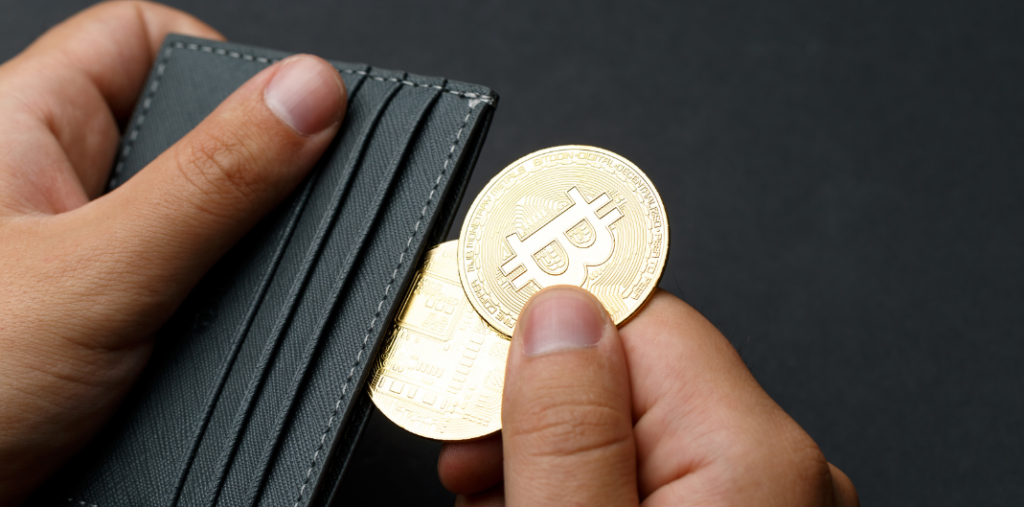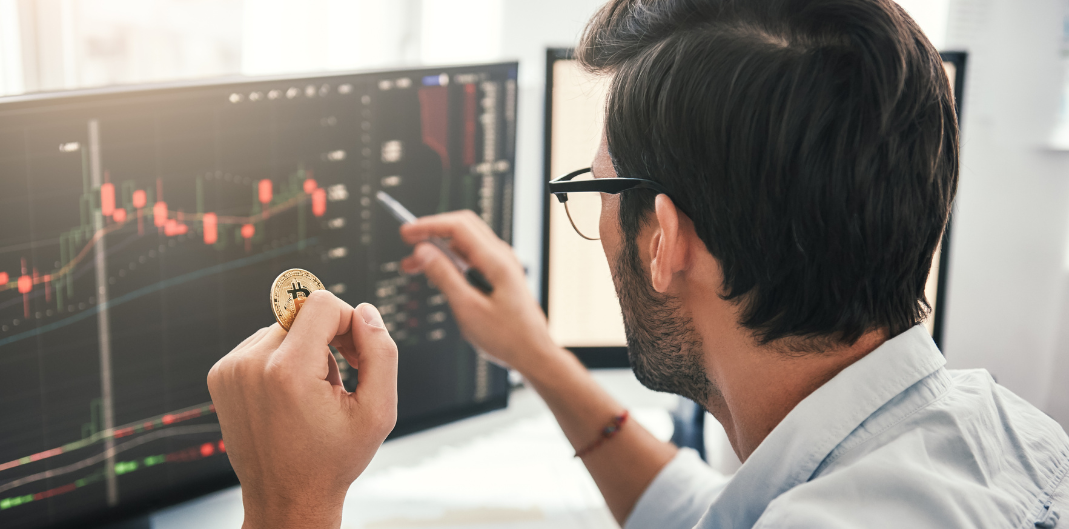- Reading time: 13 mins 27 secs
INTRODUCTION
Esta guía ha sido creada para todos aquellos que quieren aprender a operar con criptomonedas pero no saben por dónde empezar.
It covers how and why the blockchain and cryptocurrencies were devised, as well as the value of cryptos as an investment asset and the different ways you can use cryptos to generate an extra source of income.
It also provides a handy breakdown of crypto terminology and easy “how to” steps to opening a crypto trading account.
For those looking for a cryptocurrency course, we outline at the very end the 9 important learnings our course will provide.
IN THE BEGINNING
It all started with American cryptographer, computer scientist and inventor David Chaum.
In his 1982 dissertation, “Computer Systems Established, Maintained, and Trusted by Mutually Suspicious Groups,” Chaum came up with the idea of a protocol that is similar to the blockchain of today.
Nearly a decade later, fellow American cryptographers Stuart Haber and W. Scott Stornetta started work on creating a block system using cryptographic hashes to prevent document timestamps from being tampered with.
In 1992, Columbia University mathematician Dave Bayer joined Haber and Stornetta with the aim of improving the efficiency of the system by enabling the collection of several documents into one block.
From 2007-2008, Satoshi Nakamoto picked up where Haber, Stornetta and Bayer left off, working on the code for the first cryptocurrency – Bitcoin – as well as the first database to be known as – Blockchain.
Nakamoto published a white paper entitled, “Bitcoin: A Peer-to-Peer Electronic Cash System.”
On January 9th, 2009, version 0.1 of bitcoin was released by Nakamoto. This is known as the “genesis block” with the block number 0. All subsequent bitcoin created links back to this genesis block.
It is also worth noting, that embedded with the first bitcoin’s code is a line of text that reads:
“The Times 03/Jan/2009 Chancellor on brink of second bailout for banks.”
The inclusion of this newspaper headline in the code has been regarded as both a timestamp and a comment on the status quo of traditional banking following the global financial crash of 2007-2008.
Because with the birth of bitcoin and the blockchain came the all-important and revolutionary concept of decentralisation.
So who is Satoshi Nakamoto?
Well, no one knows because Satoshi Nakamoto is a pseudonym. It could be one person – or a group of coders.
One thing is for sure – Nakamoto is said to own between 750,000 and 1,100,000 bitcoin.
In November 2021, bitcoin hit its all-time high value of over US$69,000 per coin. That equals a net worth of up to US$73 billion.
At that moment in time, Satoshi Nakamoto was the 15th-richest person in the world.
“ELECTRONIC CASH” / CRYPTOCURRENCY EXPLAINED
A cryptocurrency or crypto is really nothing more than electronic cash or digital currency.
The crypto part is arguably the most important because a digital currency is founded on strong cryptography or encryption. It’s what makes it ground-breaking as a means of payment and financial transaction.
Its purpose is to act as a digital medium of exchange facilitated by a network of computers operating outside of any central authority or “middle man,” such as a government or bank.
Hence it is a decentralised system and the transactions are peer-to-peer (P2P).

A BIT MORE ABOUT BLOCKCHAIN
Records of cryptocurrency ownership are stored in a fully transparent, digital public ledger – the blockchain – which is a computerized database using strong cryptography to secure transaction records.
It also serves to control the creation of additional coins, and verify transfers of coin ownership.
In Satoshi Nakamoto’s 2008 white paper, the words “block” and “chain” appeared separately. In recent years, it is simply referred to as the blockchain.
Although the primary use of blockchains is as a ledger for cryptocurrencies, blockchain technology is now integrated into many areas of commerce, business and society.
But it’s not only as a means of exchange that cryptos and blockchain are taking the world by storm…
CRYPTOS AS A TRADING & INVESTING ASSET
When Bitcoin was first launched in January 2009, it was basically worthless for trading investments.
In May 2010 it was still valued at less than $0.01.
Then things changed between February and April 2011. Bitcoin, with the exchange ticker BTC, reached parity with the dollar at $1… and the digital currency has never looked back.
November 2013 – the price went from $350–$1,242 in the space of one month.
March 2017 – the price broke above the November 2013 high, trading above $1,290.
On May 20, 2017 – the price passed $2,000 for the first time.
Four months later, it hit $5,013.91.
It reached $17,900 on December 15, 2017, and then a new all-time high of $19,783.06 just 24 hours later.
It’s been yo-yo-ing ever since plummeting to $3,300 on December 7, 2018.
Fast forward to 2021 and BTC hits an all-time high of nearly $69,000… before sliding dramatically once again to around $17,500.
The conclusion – Bitcoin as an investment and trading asset is HIGHLY volatile… but equally FANTASTICALLY profitable.
It is the reason investors everywhere have been taking serious note since 2017… including us, here at Investment Mastery.
But, we not only take note, we teach you how to invest in and trade cryptocurrencies… at lower or no risk.
Investing and Trading: An Important Distinction
Simply put, trading focuses on making gains more quickly while investing focuses on holding onto assets for the long term.
We must look for long-term trends and overlook short-term market fluctuations when making any investment.
Trading focuses primarily on short-term fluctuations; as a result, to minimise risks and losses, trading requires an awareness of the daily market.
Every day in the crypto market, new currencies are created – there are some 10,000 at the time of writing. These are there to be invested in, and traded, but only a tiny percentage of them will survive, let alone thrive.
That is why knowledge is crucial, education paramount.
You need PROVEN, reliable strategies to be able to trade and invest successfully with cryptos and other project assets associated with the blockchain and the whole crypto ecosystem. These can be learned easily on a cryptocurrency course.
Investing in bitcoin is mostly done to accumulate more coins.
If you purchase four bitcoins at a certain price, for instance, the value of your overall asset will rise in line with the price of the coins after a while.
The most successful crypto/blockchains as of 2022 are:
Bitcoin (BTC), Ethereum (ETH), Cardano (ADA), Solana (SOL), Polkadot (DOT), Ripple (XRP), Polygon (MATIC), Stacks (STX) and Chainlink (LINK).
CRYPTO TERMINOLOGY
- Fiat Money
You will probably hear the term “fiat money” mentioned a lot when learning about cryptos.
That’s because Fiat money is the type of physical currency that is regarded as legal tender and has generally been in use for hundreds of years as a means of paying a debt.
Fiat is Latin for “let it be done.”
Legal tender is any coin or banknote authorised by a government that can be offered in payment of a debt, such as the U.S. dollar, British pound, Indian rupee, euro etc.
The paper and metal used to make Fiat money is essentially worthless.
The value of a coin or banknote is set by the government.
- Wallet
A bit like a bank account, you use a wallet to store your cryptocurrencies, however many different cryptos you may invest in.
Two types of wallets exist – a hot wallet and a cold wallet.
A cold wallet remains offline while a hot wallet remains online.
Generally, cold wallets are preferred as they are less susceptible to hacking and other cybersecurity threats.
- Exchange
Any website, or service, that allows you to purchase, trade, or convert fiat currency into digital currency is known as a cryptocurrency exchange.
Similar to the stock exchange, market rates on a cryptocurrency exchange vary.
The majority of the wallets on exchange websites are web-hosted, and you must register for an exchange account (also called a trading account) and log in before you can access your wallet.
When choosing the best cryptocurrency exchange, it is advisable to take into account supported currencies, pricing, withdrawal choices, and security.
The exchange and wallet will be vital components of your crypto trading plan.
There are various cryptocurrency exchanges and wallets available on the internet.
When choosing yours, pay extra attention to reputation, services offered and after-sale services. We only use the biggest and most secure ones.
Wallets: Ledger.com and Exodus
Exchanges: Coinbase is the biggest one and is even listed on the NYSE
- Financial Risk
Purchasing goods and services with cryptocurrency happens online and does not require disclosing personal information.
Considering privacy and identity theft problems, cryptocurrency may offer some privacy advantages to consumers.
Many exchanges use Know-Your-Customer (KYC) methods to identify users or customers.
Financial institutions can reduce financial risk while maintaining the anonymity of wallet owners thanks to the KYC procedure employed by exchanges.
It is essential to keep these financial risks in mind before investing.
- Market Movements
Extreme swings in the market can happen. Because of their high volatility, cryptocurrencies attract attention and investors.
Everyday price changes can give traders excellent profits, but they also carry a higher risk.
Unlike the stock and commodity markets, cryptocurrency transactions do not occur from a single location.
Therefore, weighing upmarket movements is an important technique to understand and master.
- Fear and Greed Index
The Fear & Greed Index is a swing-o-meter tool you can use to gauge the crypto market.
It can swing from Extreme Fear to Extreme Greed and anywhere between the two, assigning it a score between 0-100.
Extreme Fear (0-24) means cryptos are trading well below their intrinsic value.
Extreme Greed (75-100) means cryptos are being bid way above what they should be worth.
The actions of the crypto market are highly emotional.
When the market rises, people frequently become greedy, leading to FOMO (Fear Of Missing Out).
In addition, selling coins is a common irrational response to seeing red numbers.
The Fear and Greed Index is updated accordingly as per the market movements on several websites.
Other fear factors include: volatility (25%), market volume (25%), social media (15%), surveys (15%), dominance (10%) and trends (10%).
A low-risk strategy Albert Einstein once called the “Eighth Wonder of the World.”
Compound interest, also known as ‘interest on interest,’ is the concept that accumulated interest is added back onto your principal sum, with future interest calculations based on the total of both the original principal and already-accrued interest.
Using the power of the compound interest calculator with regular, consistent investing over a long period of time can be a highly effective approach to increasing your wealth – known as a compound growth strategy.
Why are we mentioning this here?
Because it’s important for any crypto investor and trader to have a financial target in mind before they start. Say you want to make £100,000 in 2 years. Setting that goal, you may reach £75,000 by the end of your allotted timeframe.
However, set a target of £150,000 and you will reach the £100,000 you were seeking.
Having a target helps set your mindset, which is vital to your success.
WAYS TO MAKE MONEY THROUGH CRYPTOS

1. Invest in Blockchain Trading Companies
Blockchain is rapidly becoming adopted as a key aspect of new technology, Artificial Intelligence, finance, and many other “mainstream” industries and enterprises.
Blockchain.com, for instance, was founded in 2011. It now has 83 million wallets created with 37 million users and overseen $1 trillion transacted.
Blockchain is here to stay, as any blockchain course will tell you.
It’s a good idea, then, to invest in companies that will undoubtedly profit from the evolution of blockchain technology.
Many publicly traded companies use blockchain technology in their operations, provide clients with blockchain-related services, or participate in the crypto industry.
Some companies focus solely on blockchain technology and/or cryptocurrencies, while others incorporate products or services that involve blockchain technology into their existing business model.
2. Invest in Small Cap Companies
A Small Cap crypto company is one whose market value is considered to be low – i.e. between $300 million and $2 billion.
Using a small cap strategy can make you money in cryptos because you are basically investing in crypto companies that show potential to grow, such as Bitcoin. Think Microsoft, Amazon, Netflix and other now big name companies. They started as an idea and attracted funding and early investors. If you had got in with them early on and stayed the course, you’d be rich.
A Small Cap strategy involves daily monitoring of a market chart to wait for “highs” and then price drops of 25%, 50% or 75% with companies that have solid growth probabilities.
It’s a very effective method, especially as it involves very little risk using a 1-3 risk/reward strategy.
But remember, the lower the market cap, the higher the risk which is why it is important to invest less money the lower down the list you go.
3. Investing in ICOs
An initial coin offering (ICO) is a process to raise funds for the development of a new coin, service, or app.
Interested investors can obtain a new cryptocurrency token created by the company in exchange for their investment.
This token might be used to invest in a business or project, or it could be used to buy assets from the company.
Anybody can launch an ICO, therefore it is imperative you undertake in-depth research to verify the organisation’s legitimacy and thereby avoid being scammed.
4. Crypto Staking
Staking is a way to secure a part of your cryptocurrency to contribute to a blockchain network.
It benefits the network and allows cryptocurrency holders to earn money from coins in their wallets.
Crypto staking participants are required to make a commitment not to withdraw their cryptocurrency before the conclusion of the predetermined time frame.
Trading Account
A trading account is an account that keeps the various investment assets that an investor has purchased, much like a bank account.
A trading account is necessary to hold any assets and purchase new ones.
It functions as an interface between the investor and the trading account.
It is impossible to buy or sell an asset without a trading account.
Place the order using your trading account, and the exchange will receive your request to purchase or sell.
When everything is finished, the asset(s) are deposited in the trading account, and the necessary sum is taken out of the bank account.
Attributes of a Trading Account
There are trading accounts for currencies, commodities, bonds, gold, exchange-traded funds, stocks… and now cryptos!
Unlike physical trading, the significant advantage is you can open trading accounts online without going to a bank or broker’s office.
Trading accounts offer one-point access.
You can access crypto exchanges through a single trading account.
Creating an online trading account allows you the freedom to trade on your phone, PC, or other devices.
Step-by-step Guide to Opening a Trading Account
Numerous investing opportunities become available after opening an online trading account.
A trading account can be opened in a few easy steps:
Step 1: After extensive research, select a brokerage platform to open a trading account. Things to consider – are the fees they charge, the trading platform’s user interface, and the value-added services.
Step 2: After deciding on a broker, you must complete an account opening form and a Know Your Customer (KYC) form.
Step 3: Scan and submit important documents, such as proof of address, proof of identification, and proof of income.
Step 4: Submit your phone number.
Step 5: Enter your email address.
Step 6: By accepting ‘I agree to the terms and conditions your account is created, and you will start receiving updates on your mobile device.
Crypto Brokerage Platforms
A crypto brokerage platform or exchange is used to buy and sell cryptos. You can also open a trading account on these sites.
There are many exchanges in operation. Here is a selection, in no particular order.
It is up to you to choose the one that you feel suits you best:
- Binance
- Coinbase
- FTX
- Crytpo.com
- Kraken
- KuCoin
- eToro
- Gemini
- Gate.io
- BitYard
- BlockFi
Download the ‘Profiting From Cryptocurrencies’ eBook by Marcus de Maria to obtain detailed information on the wonderful world of cryptocurrencies. Through this new technology, you will find a new financial paradigm that is ready to change the world. The only question now is, are you ready?
9 Important Learnings About Cryptocurrency Taught in Our Course
1.
One of the essential skills to acquire before you begin cryptocurrency trading is ensuring you learn how to comprehend market movements so you can avoid losses.
Market volatility is such that we advise you to only invest in assets that you can afford to lose, especially if you’re a beginner.
In our online video training course, you will learn how to analyse market movements better.
2.
We teach you about market patterns and temporary price trends, which helps you learn when to buy low and sell high with proven strategies developed over 20+ years.
3.
A number of factors and specific procedures must be taken into account when trading cryptocurrencies. The theory of cryptocurrencies, crypto exchanges, cryptocurrency security and crypto trading strategies are some of the topics we teach in-depth and help you get to grips with.
4.
We teach you the appropriate techniques to assist with your trading decisions in today’s cryptocurrency market and make you aware of unexpected risks.
5.
We teach you how to monitor weekly and monthly price charts that will help you assess market patterns.
6.
Mining is an essential component of Bitcoin. It protects your bitcoin by preventing your bitcoin wallet from being hacked.
In our course, we teach you about this critical aspect as well as how to protect yourself from scams.
7.
Bitcoin has become an asset with considerable store of value over recent years.
It can even be considered in the same light as gold – with one exception; gold isn’t available to everyone and is not as easy to transfer from one place to another Bitcoin can be sent anywhere in the world in minutes while it would take a lot longer to send the gold.
Our course teaches you how bitcoin can be bought, kept, retrieved, and exchanged for years to come.
8.
Anyone trading in cryptocurrency for a while won’t enter the market without a daily objective in mind.
It would be best if you defined short-term goals rather than long-term strategies when working with bitcoins.
It’s important to note that trading exists to generate little profits from regular transactions.
In our course, we help you set small daily goals for yourself, and then after attaining these small goals, we help you devise big ones.
9.
Through real-world examples, our curso de criptomonedas enlightens you and aids in your understanding of trading cryptocurrencies.
We walk you through the process of effectively managing your finances and using cryptocurrency to make money.
Okay, so now you understand how cryptocurrency works. You know the difference between the types of cryptocurrencies. You even know how to buy and sell cryptocurrencies on an exchange. The only question is, are you ready to take control of your financial future?



